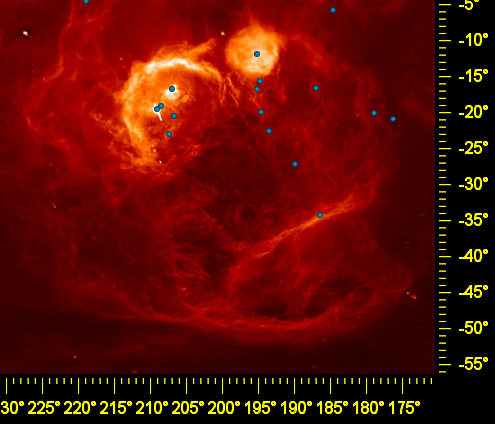
Hover your mouse over each blue dot for the name of the object, or click on the dot for a detail page. This map was created using the all-sky hydrogen-alpha map produced by Douglas Finkbeiner from data collected by the WHAM, VTSS and SHASSA hydrogen-alpha surveys.
Orion the hunter has morphed into a halloween ghoul in this hydrogen-alpha image, with two huge glowing eyes, a gaping mouth and thousands of almost anatomical filaments.
Orion is the largest star formation region in the Gould Belt, the local ring of bright stars. Because the Gould Belt is tilted at an angle of about 15°, Orion is located well below the galactic plane. (Scorpius OB2, on the opposite side of the Gould Belt, is located well above the galactic plane for the same reason.)
The larger of Orion's two glowing "eyes" surrounds the Orion OB1 association, a group of bright stars lying at a distance of about 500 parsecs that forms the belt in the constellation of Orion. The three stars most visible in Orion's belt, Mintaka, Alnilam and Alnitak, are perhaps the most prominent and best known O and bright B-class stars in the entire night sky.
The larger of the two nebulae at the centre of Orion OB1 in this image is the Flame nebula (Sh 2-277), which surrounds and is ionised by the O9.5Ib star Alnitak. The other nebula in Orion OB1 is by far the better known, however. This is the Orion nebula (M42, Sh 2-281), ionised by the Trapezium, a multiple star surrounded by a large cluster. Associated with the Orion nebula is the dimmer nebula Sh 2-279. Both the Orion and Flame nebula are visible through a gap between the Orion A and Orion B molecular clouds. Nearby is the high latitude molecular cloud MBM 110 (Sh 2-278). Surrounding the entire Orion OB1 complex is Barnard's Loop (Sh 2-276). You can see an astonishing image of most of the Barnard's Loop region here.
The smaller of Orion's two glowing "eyes" is the Lambda Orionis nebula (Sh 2-264), an HII region ionised by the O8 III subgiant star Lambda Orionis, and to a lesser extent, the 11 B stars near to it. The region around Lambda Orionis is dominated by a ring of molecular clouds whose structure can perhaps best be explained by a supernova very close to the star about 1 million years ago.
Orion OB1 and the Lambda Orionis region are only small parts of a much larger region called the Orion-Eridanus bubble. The outlines of this bubble, created by stellar winds and exploding supernova over millions of years, can be seen in the thousands of filaments of glowing gas in this hydrogen-alpha image. The close edge of the bubble is only a bit over 150 parsecs from our solar system. Nebula associated with the Orion-Eridanus bubble include Sh 2-263, at 450 parsecs and ionised by the B0 star HD 34989, Sh 2-265 at 400 parsecs, and a prominent and huge nebular ridge near the front edge of the bubble at 210 parsecs, Sh 2-245.
Some nebulae appear to be embedded in the Taurus dark cloud which lies in front of the Orion-Eridanus bubble at 140 parsecs. These include the reflection nebula or a Herbig-Haro object Sh 2-239 and Hind's nebula (NGC 1555, Sh 2-238), a Herbig-Haro object associated with the young star T Tauri. The distances to the filamentary nebulae Sh 2-260 and Sh 2-251 are unknown but they, too, appear to lie in the general direction of the Taurus dark cloud.
Other nebulae visible in this image actually lie behind the Orion-Eridanus bubble in the outer galaxy. These include Sh 2-262 at 900 parsecs, Sh 2-246 at 3700 parsecs, and Sh 2-289, which appears to lie at a very distant 10100 parsecs. Also visible at the top right of this image is the famous Crab nebula supernova remnant (M1, Sh 2-244), which lies at a distance of 1930 parsecs.
